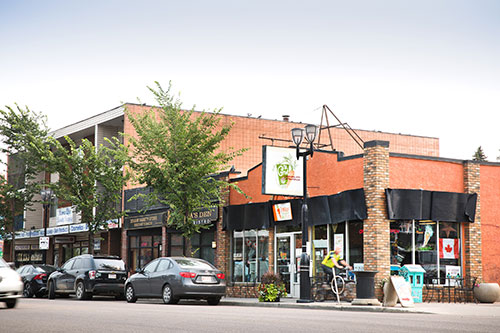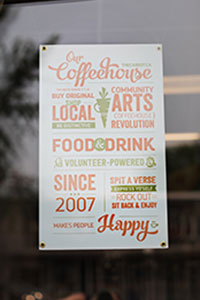Mary Ann Aquino builds community one cup of coffee at time

For someone from outside the neighbourhood, a latte served at the Carrot Community Arts Coffeehouse may be an awakening. It’s not the caffeine but the quality: the silkiness, the toasty richness, the balance that could see a double-double devotee forego the sugar. It’s an invitation to visitors to abandon any biases about Alberta Avenue.
That’s a key part of the plan at the Carrot. Situated halfway along this well-worn section of Edmonton’s 118 Ave., between the Northlands grounds to the east and NAIT Main Campus to the west, the non-profit coffeehouse turns 10 this July. For a decade, it’s been the epicentre of revitalization efforts spearheaded by Arts on the Ave, the society that opened the Carrot as its headquarters and as a community hub intended to help transform Alberta Avenue into a unique arts district.
For the last 3 of those years, Mary Ann Aquino (Culinary Arts ’10) has contributed in the way she knows best: through food. Furnished with mismatched armchairs and couches and tables small and large, the Carrot has been unpretentious and welcoming from the start. But as the young operations manager knows, a place to meet and discuss transformative ideas is nothing without good coffee. Or an unforgettable date square. Or the perfect quiche Lorraine.
That’s why Aquino went from one of Edmonton’s finest cafes to one of its most humble – and why the story of rebuilding a neighbourhood can be seen, in part, in the quality of a local coffeehouse menu.
 The human connection
The human connection
When Aquino arrived as a teenager in Canada in the mid 2000s with her family from the Philippines, they settled in a neighbourhood not far from the Carrot today. Back then, Alberta Avenue and the surrounding area struggled with more crime and social problems than most neighbourhoods.
It wasn’t long before the Aquinos – which include Mary Ann’s 3 brothers – moved to a quieter location.
Studying at NAIT set a trajectory that would bring her back.
“When I took Culinary Arts, my purpose was to make other people happy with what I do,” says Aquino. She did her practicum at the upscale Fairmont Hotel MacDonald and followed that with a job on trendy 124 St. at the Duchess Bake Shop, where she honed her skills as a pastry chef using imported French flour, butter and chocolate.
She enjoyed the work but felt the human connection that had led her to it was missing. “I wanted to get back into community,” says Aquino. When the position opened at the Carrot, it offered just that, as well as a way to satisfy an artistic nature that was emerging, nurtured by a graphic design course she’d been taking on the side.
Today, she sets the menu, handles budgeting and ordering from suppliers on or near Alberta Avenue (the Carrot is too small for its own kitchen), ensures that her volunteer baristas know how to make a perfect latte, helps curate the art that makes up the café’s revolving gallery, and helps project manage community-building events such as the Kaleido and Deep Freeze festivals put on by Arts on the Ave. Deep Freeze, held last January, attracted 65,000 people.
“It’s fulfilling,” says the 26-year old. “I feel like I’m contributing to the bigger picture.”
Christy Morin would call that an understatement. “Mary Ann is a gift to the Carrot and Arts on the Ave,” says the executive director of the latter organization. She points out how Aquino has made partnerships with the local food community that have sustained the Carrot and its festivals, for which she serves as executive chef. Among those partners is NAIT, its kitchens serving as food prep HQ as needed.
“She’s my right hand,” says Morin.
What's happening at the carrot
As an arts-oriented HQ for community-building, the Carrot Community Arts Coffeehouse shows and sells work by local artists and artisans and hosts frequent open stages, concerts and other events.
It's also a centre for community outreach for organizations such as the Edmonton Police Service, which regularly visits for "Coffee with Cops" to discuss issues with residents.
Keep up with goings-on at the Carrot at their events calendar.

“A power centre”
Just how effective can a corner café be in helping to turn around a once beleaguered neighbourhood? “Huge,” says Chris Dulaba (Urban and Regional Planning Technology ’99), a partner at Beljan Development.
“That café hits it home on many fronts – this is a grassroots placemaking effort.”
As a planner and developer, Dulaba has applied the concept of “placemaking” to residential and commercial projects across Edmonton. Technically, that means leveraging community assets to create places that enhance the happiness and well-being of residents. He looks at the Carrot as being one of those assets – setting a tone as a gathering place and catalyst for creating community.
“That leads to a snowball effect,” he says. In addition to attracting a diverse group of people (“food draws in people of different backgrounds and likewise does art”), it can spark similar pride of place in surrounding businesses, like candles lit from a single match.
Since the Carrot opened 10 years ago, the Avenue has changed. Crime stats, for instance, are a quarter of what they were in 2009, making it statistically safer than downtown.
After growing up in the area in the 1940s and ’50s, Myrna Kostash has noticed the change in her old neighbourhood.
“There’s now a sense of local pride,” says the writer and 10-year volunteer barista at the café. “This is becoming a destination area for people to get to know the city better.” Kostash sees the Carrot as one of the reasons. “This is a power centre.”
Her statement is a reminder that power comes in many forms, some of them subtle. Aquino makes decisions daily that have helped the Carrot reach its 10th anniversary, and which will help it proceed with plans to expand into a new facility. Sometimes, those decisions are much simpler yet no less important.
“I’ve seen people walk in and say, ‘I only have a dollar – what can I buy?’” says Aquino. She’s been known to discount a juice or offer a still-fresh sandwich from the day before. To her, it’s part of the bigger picture: the power food has in bringing people together.
“As a community hub, that’s what we want to have happen,” she says. “It makes you more human.”
.jpg)